1971 Dutch Grand Prix race report
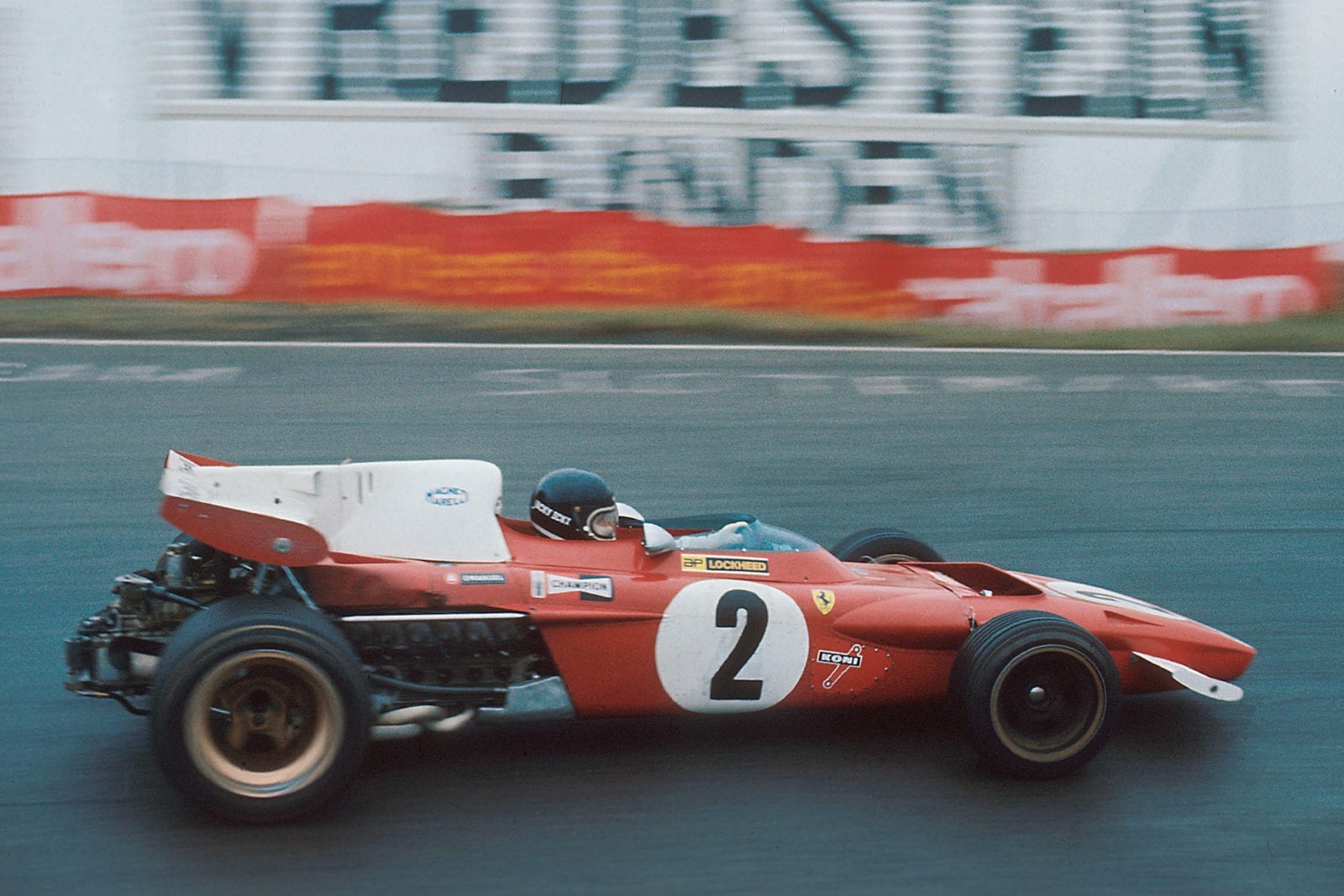
Jacky Ickx driving to his first win of the year for Ferrari
Motorsport Images
Sports-car drivers win the day
Zandvoort, Holland, June 20th
Although some of the scandal-mongering newspapers insist that the Zandvoort race-track is doomed and the future of the Dutch Grand Prix is in doubt, nothing could be further from the truth; the year-long activities at the Dutch circuit continue to make the whole setup a good business proposition, of which the local town council benefit by receiving a large slice of the income, as distinct from the profit.
With the ever-increasing demands by the Formula One entrants and further demands of expenditure of hard cash by the GPDA Safety Brigade, there are times when one is given to wondering why organisers carry on with Grand Prix racing. Whatever the reason, this year’s Dutch Grand Prix saw a bumper entry and there was no squabbling or dissatisfaction over who was to start as all 25 drivers listed in the entry were to be accepted on the starting grid. After scrutineering had taken place on Friday morning, practice got under way in the afternoon with a following wind blowing down the straight, thus encouraging “a fast day” as it is known. The weather was very grey and gloomy and with the scrub grass and sand dunes all around and the muddy-looking North Sea just behind the grandstands, the Zandvoort circuit was about as gay and entrancing as it is ever likely to be and one began to see why everyone likes circuits like Barcelona and Monte Carlo.
Qualifying
However, the job in hand was to put in some fast laps as soon as possible as there was every likelihood of the weather breaking up later on, and the bogey time was the 1 min. 19.23 sec. set up by Ickx last year in the original prototype flat-12-cylinder Ferrari. Now there were not only two similar cars as spares, with 1971 engines, but three of the second version of the flat-12-cylindered cars, the 312B/2 models, and it was Regazzoni setting the pace with number 5 car, having been out earlier in the week doing some unofficial practice. He had got down to a cool 1 min. 17.98 sec. when the engine blew up and the car was wheeled round the back of the pits with oil dripping from everywhere, and work began on removing the engine and installing a new one.
Also in the first part of the afternoon Team Lotus had a disaster, for Walker had barely begun to circulate in Fittipaldi’s Lotus 72 when he fell off the edge of the track and damaged the rear end too badly for immediate repair, so that was the end of all Charlton’s hopes of joining Team Lotus for this race. He was to have taken over 72D/R5 when the turbine car was ready for Walker to drive.
It was quite clear that laps under 1 min. 20 sec. were the least that could be considered competitive and both Andretti and Ickx were well inside this figure by mid-afternoon, as was Wisell, who was now alone in upholding Lotus’ honour, Stommelen was in there with the second of the 1971 Surtees cars, and Ganley also, indicating that the sparkle that appeared in his driving at Hockenheim had not been a flash in the pan. Stewart was experimenting with the new Girling double-disc brakes on the latest Tyrrell car and amid a certain amount of detail bothers he just scraped in under the 1 min. 20 sec. barrier.
After the mid-afternoon break things really began to happen and Ickx set up a new fastest time with 1 min. 17.42 sec., with Rodriguez right behind him with 1 min. 17.46 sec., these two 12-cylinder cars being visibly faster down the straight than anything else. After a bit more experimenting with the new brakes on the Tyrrell, Stewart went out and very quickly got within striking distance of the “twelves” with 1 min. 17.64 sec., and you could almost hear “The Good Ford” saying “Thank the Lord for Stewart”. Things were really warming up now and the 1 min. 20 sec. bogey time was for beginners, 1 min. 19 sec. was for the “pros”, 1 min, 18 sec. for the “stars” and 1 min. 17 sec. for the “aces”, with more yet to come.
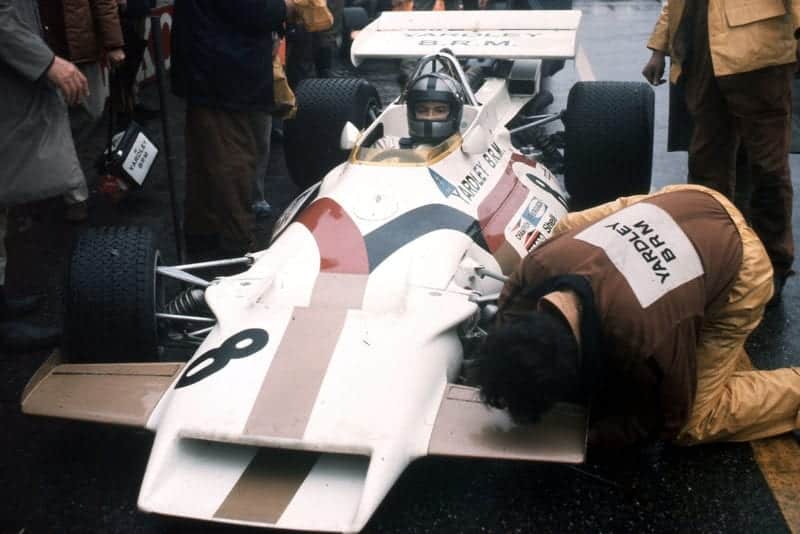
Pedro Rodriguez qualified his BRM 2nd behind Ickx
Motorsport Images
While the general increase in pace was going on Regazzoni crashed his spare Ferrari, number 4, and just before practice ended Andretti had a spectacular accident past the pits in the brand-new 312B/2 and it was later revealed that both were the result of tyres centrifuging inwards on some new ultra-wide rims. This meant a reshuffle in the Ferrari camp, and Andretti took over the remaining spare car on the following day, while Regazzoni had his 1971 car back again.
There seemed every possibility that the “aces” would break 1 min. 17 sec. in the following practice periods, providing everything stayed constant, but as so often happens things did not remain constant and on Saturday morning it was pouring with rain. So bad was the rain, and prospects for any improvement in the weather so remote, that a lot of drivers gave Saturday morning practice a miss, knowing that there was plenty of time in the afternoon to splash round in the rain. Unfortunately this caught them out, for suddenly the weather cleared and, apart from a change in direction of the wind, the afternoon became fine. Those who had deliberately not practised in the morning, like Surtees, Cevert and Hulme, were not to know they had been caught out until next morning when the rain returned.
Due to an impressive piece of organisation and a lot of hard work Team Lotus had got the Pratt and Whitney turbine engine back from Canada and installed in the 4-wheel-drive chassis and Walker was out practising as soon as possible. It was not possible to effect immediate repairs to the crashed Lotus 72 so Charlton had to remain a spectator. Andretti took over the remaining spare Ferrari and Regazzoni had his 1971 car back again. So bad were the conditions during the morning that even the fastest laps recorded were 20 seconds slower than the previous day’s times. Only Regazzoni and Rodriguez broke the 1 min. 40 sec. mark and then by only a gnat’s whisker. During the lunch break conditions suddenly improved and the afternoon became warm and dry, but the wind was now head-on up the straight and though everyone was out and trying hard there was no question of approaching the Friday times, so for most drivers their first day’s times were the ones to count for grid positions.
Regazzoni and Siffert were fastest, with Rodriguez, Stewart and Ickx close behind. As Peterson was not too happy with the general feel of the new March 711 it had been put away, and he was concentrating on the early model, with the Cosworth V8 engine. The Ferraris and BRMs were significantly faster down the straight than all the other cars, even the Matras, and but for Stewart and the Tyrrell the outcome of the two days’ practice would have been a clean sweep for the 12-cylinder cars.
Race
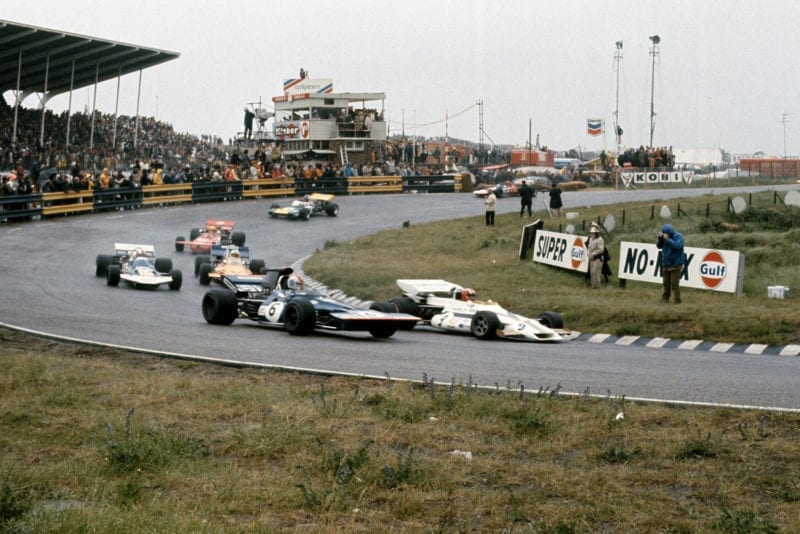
Francois Cevert battles with Rolf Stommelen
Motorsport Images
Race day was as wet and dull as Zandvoort has ever known, yet an impressive crowd of spectators poured into the circuit all morning, as everyone prepared for a really wet race, with knobbly wet-weather tyres, waterproofing over the electrics and much preparation for keeping water out of visors and cockpits. In view of the dreadful conditions a 15-minute free practice session was allowed before the start so that drivers could weigh up the conditions of the track. While everyone was assembling on the “dummy grid” the Ferrari mechanics suddenly rushed Andretti’s car back to the pits and feverishly started to change the petrol pumps, as the system had lost all its pressure. Andretti had to sit patiently in the cockpit while mechanics worked away at the back of the car and, though the Dutch officials delayed the start as long as possible, they could wait no longer and one by one engines were started up and preparations made to move the 23 cars forward to the starting grid.
Ickx made a spectacular practice start off the “dummy grid”, and then he, Rodriguez and Stewart led the rows of cars forward to the starting line. The flag fell and so slippery was the track that nothing seemed to happen for seconds, and then the Firestone tyres of Ickx and Rodriguez found grip and pulled away from Stewart, who was still trying to make his Goodyears grip the road. As the field poured into the Tarzan hairpin in a cloud of spray Amon had his Matra right on the outside edge of the raised corner and was going round the outside of Stewart, but just failed to get by so that the order round the back of the pits and away across the sand dunes was lckx, Rodriguez, Stewart, Amon, Regazzoni, Surtees. In the opening scramble Siffert and Soler-Roig had spins on the wet track and there was a lot of dodging about but no damage.
Ickx led from Rodriguez on the opening lap, and once again Amon went high on the banked Tarzan corner, and this time fell over the edge into the sand and the wire mesh safety fence, where the Matra remained stuck while everyone went by. At the end of lap 2 the Ferrari of Ickx and the BRM of Rodriguez had opened up quite a considerable gap from Stewart, who was still in third place, but as the dark blue Tyrrell went into the Tarzan comer at the end of the main straight it spun helplessly and Stewart had to sit and watch while a whole row of smiling opponents went by him, and he was in eighth place when he got going again. As he motored off from the corner leaving Amon still working away to get his Matra out of the safety fence, Andretti joined the race from the pit lane with a great rush of noise and spray. He arrived at the first corner and promptly spun, luckily staying on the track, and set off at a more sedate pace, after which Amon got his Matra disentangled and motored round to the pits but the radiator was split so that was that.
By the end of the third lap the Dutch Grand Prix was over for all except Ickx and Rodriguez, who were way out on their own and indulging in a motor race that must go down in history. On the next lap Pescarolo got his Frank Williams March 711 all sideways and out of control and ran into Schenken’s Brabham as they accelerated out of the Tarzan hairpin along the short straight behind the pits, and the rather vulnerable aerofoil on the nose of the March was badly bent. Pescarolo stopped at the pits next time round and had the complete aerofoil removed and continued the race with the front of the March looking very light and almost airborne.
Accidents were by no means over, for, as the Lotus turbine car ended lap 5, Walker misjudged his braking point past the pits and went straight on over the bank and almost out of sight amongst the restraining mesh fences and advertising hoardings, escaping unscathed, but with the nose of the Lotus wiped off. It was no day at all for Team Lotus for two laps later Wisell pulled his Lotus 72 smartly out of his race with Peterson’s March and stopped just beyond the pits with a rear wheel coming loose. He reversed back into the pit lane but of course this entailed immediate disqualification. While this was going on there was another “coming together” at the end of the main straight when Galli and Cevert got tangled together under-braking and the March and the Tyrrell ended up in the sand.
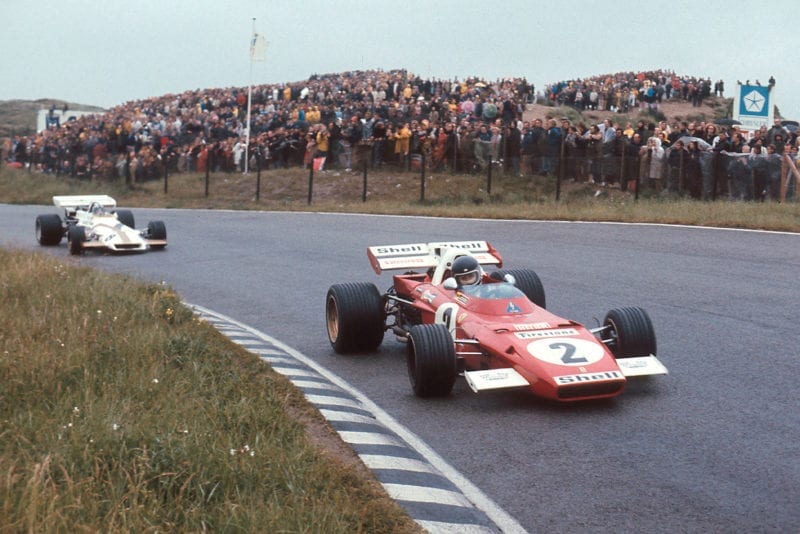
Ickx duels with Rodriguez
Motorsport Images
Amidst all this unruliness Ickx and Rodriguez were really getting on with a motor race and they ended lap 8 side-by-side, trying to out-brake each other for the Tarzan hairpin, and it was Rodriguez who got in front as they fought each other all the way round the twisty bits behind the pits. Regazzoni was a comfortable third, followed by Surtees, Peterson, Beltoise and Stewart, but the little Scot was fast giving up and let Stommelen, Ganley and Siffert go by on the next lap. Andretti retired at the pits as his engine had not worked properly even with the new fuel pumps fitted, and Hulme, van Lennep and Hill were having a little race of their own at the end of the field, apart from the stragglers like Soler-Roig, Barber, Schenken, Gethin and Pescarolo.
By 10 laps, with 60 still to go, the two tigers battling for the lead were lapping the end of the field and they raced in and out of the traffic the way they do in long-distance sports-car races. Nothing was sacred to them and they swept past Hill, van Lennep, Hulme and Stewart as if they were not there. Then they whittled down the distance to Ganley and Beltoise, who had been overtaken by Siffert, and then they caught the Swiss and after that Stommelen, all the while Rodriguez being first and Ickx second. Now the rout of the also-sans ended and Regazzoni, Peterson and Surtees remained unlapped. The Swedish March driver had overtaken Surtees on lap 11, but could not get away and the two cars were circulating in close company, in fourth and fifth places. Down at the back of the field Stewart let Hill, van Lennep and Hulme go past and was going so slowly that the leaders were soon to lap him again.
It was now very obvious that the first seven cars were running on knobbly Firestone wet-weather tyres, and the Goodyear-shod cars could not keep up, apart from Beltoise, who had his Matra in eighth place, whereas Hill, Hulme and Stewart were just so far back it was pathetic to watch. On lap 20 Hulme gave up even more than Stewart had done, and let the Scot get in front just as Rodriguez and lckx swept by for the second time. The Dutch driver Gijs van Lennep, driving the original 1970 Surtees car, pleased his fellow countrymen by leaving behind the three ex-World Champions, Hill, Stewart and Hulme, and even though he was on Firestone tyres and they were on Goodyears, it was still a commendable effort, for they really should have been up in front of Beltoise, who was just ahead of van Lennep.
The circuit was still desperately wet and slippery and, though the rain eased off, a sea mist was lying about everywhere making conditions terribly greasy, but this did not seem to worry Rodriguez and Ickx, who were still hard at it, even though their lap times were around 1 min. 35 sec.
Shortly before half-distance lckx began to put the pressure on harder and taking opportunities caused by slower cars in front of the BRM he had the Ferrari’s nose right up with the rear tyres of the Bourne car. On lap 30 Ickx got the lead back again, but Rodriguez was not giving up and side-by-side they ran, coming up behind Schenken and Pescarolo, who were together once more, even though they had both had pit stops, the March to have its nose fin removed and the Brabham to have its accelerator linkage fixed when it came adrift.
For a moment the road was completely blocked for the Ferrari and BRM, and then Rodriguez dived between the two cars in front and was back in the lead again. That did not suit Ickx at all, and after one more lap he again scrabbled past the BRM and back into the lead. All this would have been great stuff in perfect conditions, but on the wet and slippery track it was unbelievable and motor racing at its best, and this furious pace now carried them past Surtees and Petersen, so that only Regazzoni remained on the same lap as the two tough little heroes out at the front. Siffert was firmly in sixth place, followed by Ganley equally surely in seventh place, and then van Lennep driving a very good smooth race in his first Grand Prix event. Stommelen had gone off the road at the end of the straight and been helped back on again, which cawed his disqualification. Then came the Goodyear-shod runners, with Beltoise leading them and Hill trying very hard to catch the Matra, while Stewart was doing a good imitation of a typical Swiss Sunday motorist, telling other people what to do instead of getting on with his own driving, and HuIme was wishing he was in a nice comfy Can-Am race where there are not too many racing drivers about.
After tangling with Galli’s March-Alfa Romeo, which was quite badly bent, Cevert found that his Tyrrell had only suffered a dent in the monocoque on the right-hand side and a flattened oil catch-tank at the rear, so he extricated the car from the sand and went on racing. The March was still just off the edge of the track and Stewart was trying to encourage the marshals to drag it further out of the way. Cevert’s race came to a sudden stop when the left rear suspension collapsed, obviously as a result of the earlier impact, and the Tyrrell spun off the road as the drive-shaft came apart and bent the exhaust system and the rear cross-member over the gearbox.
Although the weather did not exactly improve, the rain let up and Ickx found that he could pull away from the BRM out of the two slow hairpins, as the Ferrari engine was pulling solidly from fairly low r.p.m., letting him use third gear, whereas Rodriguez was having to use first gear and keep the r.p.m. high to prevent it “fluffing” on acceleration. On the fast bends round the back of the circuit the Mexican found he could gain ground on his Belgian rival, but in the overall lap he was losing contact and for the last part of the race had to settle for second place and watch the Ferrari pull slowly but surely away.
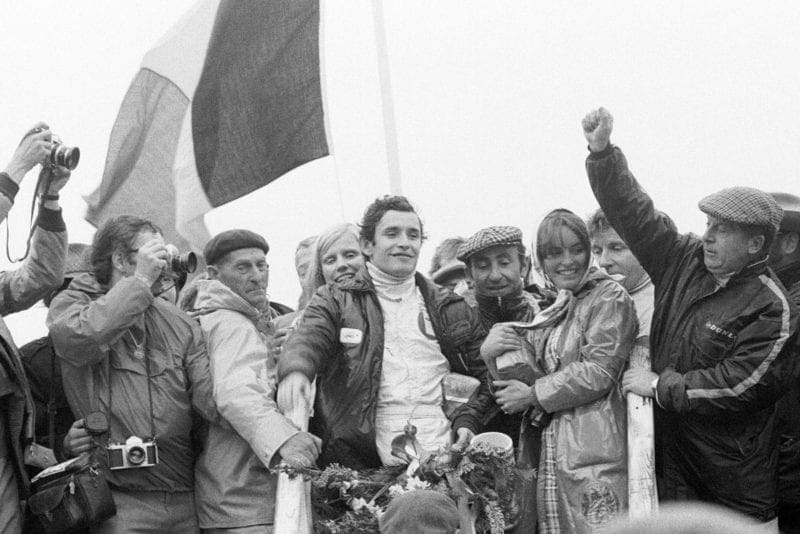
Ickx is triumphant on the podium
Motorsport Images
At the back of the field Soler-Roig had the Cosworth engine in his March 711 break and he poured out oil and smoke until the whole thing came to a grinding halt on the back of the circuit. Then with only five laps to go Regazzoni misjudged his braking at the end of the straight and slid off the road into the wire mesh fence, but luckily was able to back out to rejoin the race still in third place. The fibre-glass nose of the Ferrari was shattered and the radiator pushed out of line, but there were no leaks so he pressed on, scattering bits of fibre-glass as he went. He had been lapped by the two “racers” and they had lapped Siffert, Surtees and Peterson for the second time, and the three Goodyear-shod ex-World Champions more times than was decent.
The lap after Regazzoni made his mistake, Surtees made one out of the slow Hunzerug hairpin and clouted the guard rail with his right front wheel, which bent the suspension out of shape, and, with fingers crossed and an anxious eye on the front end, he slowed down and managed two more laps, by which time Ickx had crossed the line the winner of the 1971 Dutch GP by 8 seconds, he and Rodriguez having put on the sort of display of racing that Grand Prix badly needs.—D. S. J.
